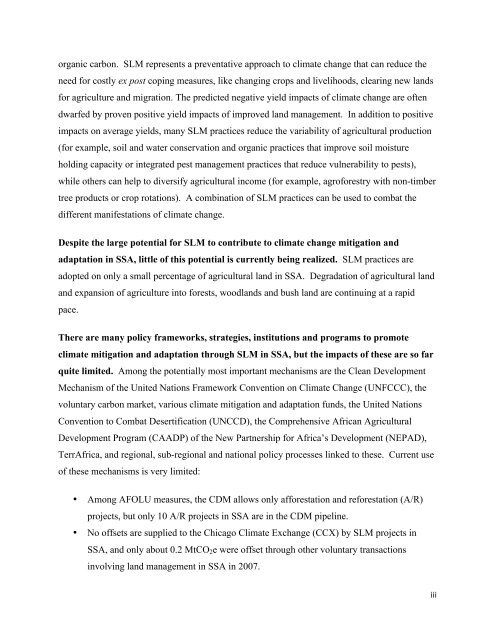The Role of Sustainable Land Management for Climate ... - CAADP
The Role of Sustainable Land Management for Climate ... - CAADP
The Role of Sustainable Land Management for Climate ... - CAADP
Create successful ePaper yourself
Turn your PDF publications into a flip-book with our unique Google optimized e-Paper software.
!<br />
organic carbon. SLM represents a preventative approach to climate change that can reduce the<br />
need <strong>for</strong> costly ex post coping measures, like changing crops and livelihoods, clearing new lands<br />
<strong>for</strong> agriculture and migration. <strong>The</strong> predicted negative yield impacts <strong>of</strong> climate change are <strong>of</strong>ten<br />
dwarfed by proven positive yield impacts <strong>of</strong> improved land management. In addition to positive<br />
impacts on average yields, many SLM practices reduce the variability <strong>of</strong> agricultural production<br />
(<strong>for</strong> example, soil and water conservation and organic practices that improve soil moisture<br />
holding capacity or integrated pest management practices that reduce vulnerability to pests),<br />
while others can help to diversify agricultural income (<strong>for</strong> example, agr<strong>of</strong>orestry with non-timber<br />
tree products or crop rotations). A combination <strong>of</strong> SLM practices can be used to combat the<br />
different manifestations <strong>of</strong> climate change.<br />
Despite the large potential <strong>for</strong> SLM to contribute to climate change mitigation and<br />
adaptation in SSA, little <strong>of</strong> this potential is currently being realized. SLM practices are<br />
adopted on only a small percentage <strong>of</strong> agricultural land in SSA. Degradation <strong>of</strong> agricultural land<br />
and expansion <strong>of</strong> agriculture into <strong>for</strong>ests, woodlands and bush land are continuing at a rapid<br />
pace.<br />
<strong>The</strong>re are many policy frameworks, strategies, institutions and programs to promote<br />
climate mitigation and adaptation through SLM in SSA, but the impacts <strong>of</strong> these are so far<br />
quite limited. Among the potentially most important mechanisms are the Clean Development<br />
Mechanism <strong>of</strong> the United Nations Framework Convention on <strong>Climate</strong> Change (UNFCCC), the<br />
voluntary carbon market, various climate mitigation and adaptation funds, the United Nations<br />
Convention to Combat Desertification (UNCCD), the Comprehensive African Agricultural<br />
Development Program (<strong>CAADP</strong>) <strong>of</strong> the New Partnership <strong>for</strong> Africa’s Development (NEPAD),<br />
TerrAfrica, and regional, sub-regional and national policy processes linked to these. Current use<br />
<strong>of</strong> these mechanisms is very limited:<br />
• Among AFOLU measures, the CDM allows only af<strong>for</strong>estation and re<strong>for</strong>estation (A/R)<br />
projects, but only 10 A/R projects in SSA are in the CDM pipeline.<br />
• No <strong>of</strong>fsets are supplied to the Chicago <strong>Climate</strong> Exchange (CCX) by SLM projects in<br />
SSA, and only about 0.2 MtCO 2 e were <strong>of</strong>fset through other voluntary transactions<br />
involving land management in SSA in 2007.<br />
!<br />
"""!

















